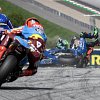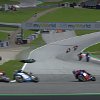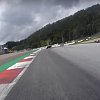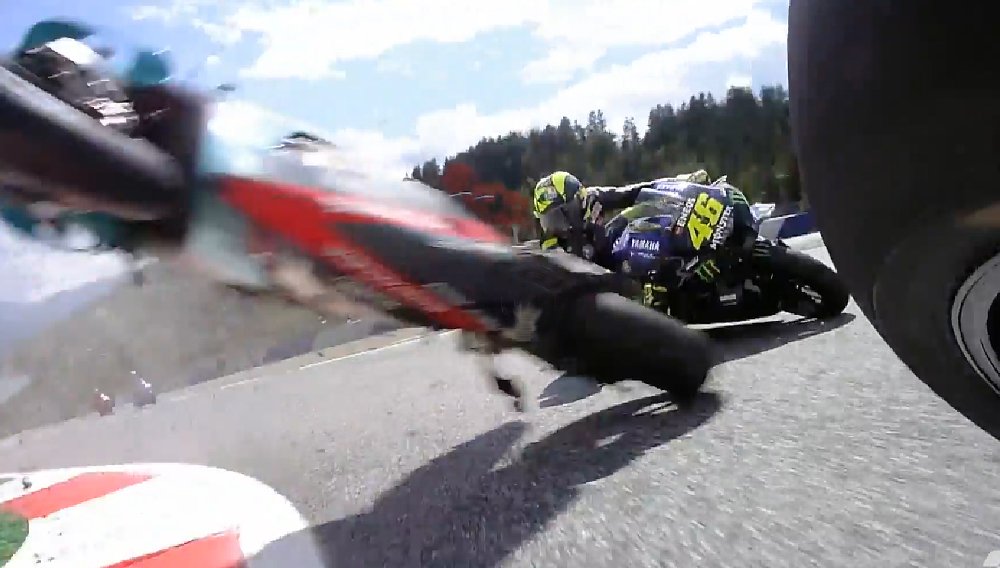The talk of the Austrian GP round this past weekend at Red Bull Ring has been largely centered around either the major incident that brought a red flag and a halt to the MotoGP race, or the similarly scary pileup in Moto2 that also stopped the race. It’s most interesting to me because I believe we can learn from one of them, while the other we cannot.
The crash in Moto2 was, unfortunately, a familiar situation. (See the full MotoGP.com video here.) A rider (this time, championship leader Enea Bastianini) crashes on the exit of a corner and for one reason or another the bike skitters down the circuit and comes to a rest in the middle of the track. The 2007 round at Brno always comes to mind for me — a particularly devious situation because the crashed bike kicked up enough dust to obscure the vision of the helpless rider behind.

To my eye, these accidents are horrible but more or less unavoidable. In the violence of a crash a motorcycle can go anywhere, and considering the rider is usually doing his or her best to keep the bike on the circuit it makes sense that sometimes the stricken machine stops in the track. Whether it’s a cloud of dust or riders in front, there’s always a chance that a racer won’t see the obstacle until too late. Check that, there is a way to avoid these crashes and that’s to simply not race. Despite the dangers, I’m not ready to concede that as a solution.
Sunday's MotoGP race was a different story. Johann Zarco and Franco Morbidelli crashed when they touched at approximately 200 miles per hour. (You can see the full MotoGP.com video here.) Some have suggested that Zarco was careless in his riding while Zarco has said his data shows he did not brake sooner than usual on that lap, but I’m not here to argue over how it could have been avoided or the specific physics of this situation. Racers are going to bump into each other at speed and there’s no solving that. What made this situation so scary was that in this case the bikes of Zarco and Morbidelli each careened through the runoff areas and crossed the track at the next corner, which at the Red Bull Ring happens to be one of the slowest and most acute on the Grand Prix calendar.

That means there’s potential for riders to be turning, at a sharp angle, and riding perpendicular to the direction of the bikes traveling at high speeds just behind them. The bend in the track that is turn two makes the situation we saw even more likely to happen. It was an incident that most of the riders have chalked up to bad luck, but especially because a tragedy was so narrowly avoided it seems like it’s worth thinking about what measures could have made the situation a little better.
Zarco’s Ducati hit a section of air fence protruding from the wall on the right side of the track so hard that it punched straight through and still nearly collected Maverick Viñales. Still, it was in the right place doing the right thing. Why not extend that fence out farther, to offer more protection for riders who might be ahead and already turning right? As it happened, Morbidelli’s machine would probably have avoided that fence, and even if it had hit a barrier that might have been worse in this case, since in the end his bike missed everyone. Hopefully there is no “next crash” in this turn, but if there is, it seems like some more barriers there would help. This tweet from a racetrack designer also points out how the materials used in runoff areas can also change the outcome.
Similar speed, similar bike, different run off. Totally different outcome. pic.twitter.com/ToFjDGZ7jf
— Jarno (@jarnozaffelli) August 17, 2020
What's not easy to change is the layout of the track itself and there are other corners on the MotoGP calendar where something like this could happen. The first place that comes to mind is the legendary Maggotts and Becketts set of curves at Silverstone, where an error on entry to one of the corners could send a motorcycle flying across the next apex and into riders ahead. Or, the approach to the La Chapelle at Le Mans, where a fast exit from a left-hander leads to downhill braking into a right-hand turn. There are probably a half-dozen more places with obvious potential for crashed bikes to cross the racing line at speed. I know that freak accidents are impossible to predict, but it seems plausible to use this Austrian GP incident as a tool for learning.
At least a few retired World Superbike and Grand Prix riders have come out as saying that fast kinks like turn two at the Red Bull Ring are part of what makes racing great. Having the gall to bail into that braking zone at full tilt is thrilling to do and part of the mystique of the sport, some say. And I agree. My perspective is that of a mostly retired club racer with a medium-sized career, and yet even I understand the stimulation involved with calculating a challenge and using skill to do it better than the competition. It’s excellent, and it’s why we love watching racers in world championship racing operate at the highest level.

There’s no easy answer here. If you run partitions, even soft ones, across the runoff areas of Maggotts and Becketts (for example) a rider who makes a mistake but stays on board the bike will plow into a section air fence rather than keep the bike upright. If every corner must be preceded by a completely straight piece of track, we lose some dynamism in the sport. Even then, any hard braking area is always a danger zone for closing speeds and riders being hit — turn 11 at Motegi, turn 12 at COTA, the list goes on.
The two good outcomes of Sunday's races are that nobody got seriously hurt and the huge discussion that has followed is giving the powers that be in MotoGP lots to information and perspectives to think about. I hope they can consider all that information critically and apply the lessons learned across the calendar. The racing gods won’t always be so kind.










